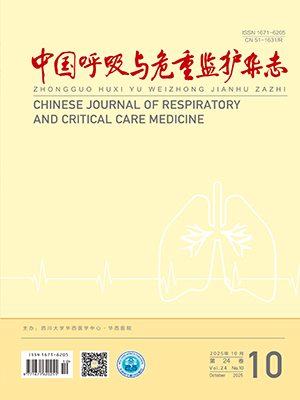| 1. |
唐神结, 李亮, 严晓峰, 等. 非结核分枝杆菌病诊断与治疗指南(2020年版). 中华结核和呼吸杂志, 2020, 43(11): 918-946.
|
| 2. |
刘莉. 人类免疫缺陷病毒/艾滋病患者合并非结核分枝杆菌感染诊治专家共识. 传染病信息, 2019, 32(06): 481-489.
|
| 3. |
钱源, 范怀艳, 何志坚, 等. 云南省昭通地区结核分枝杆菌临床分离株遗传多样性和耐药分子特征. 传染病信息, 2024, 37(1): 35-40.
|
| 4. |
Narimisa N, Goodarzi F, Bostanghadiri N, et al. Prevalence of antibiotic resistance in clinical isolates of Mycobacterium kansasii: a systematic review and meta-analysis. Expert Rev Anti Infect Ther. 2024, 22(8): 669-679.
|
| 5. |
Narimisa N, Bostanghadiri N, Goodarzi F, et al. Prevalence of Mycobacterium kansasii in clinical and environmental isolates, a systematic review and meta-analysis. Front Microbiol. 2024, 19;15: 1321273.
|
| 6. |
古丽米拉·达列力汗, 宋玉霞, 李弘, 等. 艾滋病合并结核病患者结核分枝杆菌耐药分析. 传染病信息, 2022, 35(3): 245-247+258.
|
| 7. |
曹齐, 聂静敏, 黄锐. 艾滋病合并鸟-胞内分枝杆菌复合群中枢神经系统感染1例并文献复习. 传染病信息, 2022, 35(5): 474-478.
|
| 8. |
Huayllani MT, Sisti A, Boczar D, et al. Chronic Tenosynovitis of the Upper Extremities Caused by Mycobacterium kansasii : A Clinical Case and Systematic Review of Literature. Indian J Plast Surg, 2020, 53(1): 25-35.
|
| 9. |
储美萍, 钱静娟, 程亮, 等. 非结核分枝杆菌病临床特征及临床分离株的菌种分布及耐药性. 中华医院感染学杂志, 2024, 34(1): 41-44.
|
| 10. |
曹杨, 陈晓林, 贾凌, 等. 播散性堪萨斯分枝杆菌病的临床特征、诊断及治疗(附1例分析). 山东医药, 2023, 63(6): 82-85.
|
| 11. |
任汝颜, 于霞, 黄海荣. 堪萨斯分枝杆菌鉴定及耐药机制研究进展. 实用医学杂志, 2022, 38(6): 669-672.
|
| 12. |
王斌, 李群, 刘海灿, 等. 23株非结核分枝杆菌药物敏感性试验分析. 中国人兽共患病学报, 2018, 34(4): 372-375.
|
| 13. |
陈喜凯, 裘丹红, 沈伟伟, 等. 台州市非结核分枝杆菌的菌种分布特征和流行状况分析. 中国卫生检验杂志, 2023, 33(5): 536-538.
|
| 14. |
高春景, 杨洋, 李星, 等. 40例堪萨斯分枝杆菌肺病的临床特征及药敏特点分析. 临床肺科杂志, 2022, 27(1): 58-62.
|
| 15. |
王嫩寒, 赵琰枫, 田丽丽, 等. 荧光PCR探针熔解曲线技术检测痰标本中结核分枝杆菌异烟肼耐药性的研究. 实用医学杂志, 2023, 39(20): 2664-2670.
|
| 16. |
任汝颜, 薛毅, 梁倩, 等. 堪萨斯分枝杆菌临床分离株对异烟肼敏感性差异机制研究. 中国防痨杂志, 2023, 45(8): 728-733.
|
| 17. |
于圣铭, 夏良华, 詹佳欢, 等. 江西省耐多药结核分枝杆菌链霉素基因突变特征. 实用医学杂志, 2024, 40(1): 91-96.
|
| 18. |
贺文从, 谭云洪, 刘彬彬, 等. 全基因组测序预测结核分枝杆菌对氟喹诺酮类药物耐药性的应用价值研究. 中华检验医学杂志, 2024, 47(11): 1299-1305.
|
| 19. |
AKRAM S M, RAWLA P. Mycobacterium Kansasii[M]. In: StatPearls. Treasure Island (FL)StatPearls Publishing;December 12, 2021.
|
| 20. |
詹建, 游国庆, 何霞, 等. 两种结核分枝杆菌氟喹诺酮类药物耐药性检测方法比较及不一致原因初探. 中国防痨杂志, 2023, 45(11): 1058-1063.
|
| 21. |
苏碧仪, 谭耀驹, 刘欣, 等. 广东地区脓肿分枝杆菌复合群对克拉霉素的耐药机制研究. 热带医学杂志, 2021, 21(6): 700-704.
|




